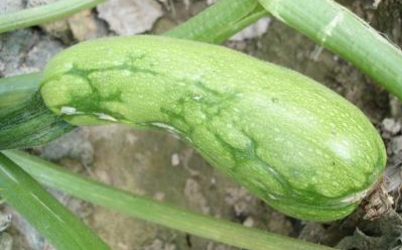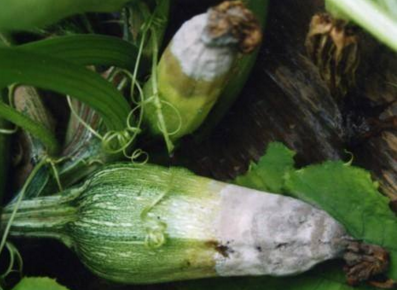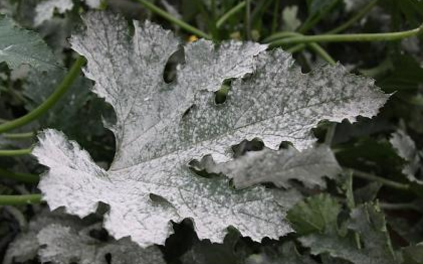Characteristics and control techniques of common diseases of summer squash
Viral disease
This disease is also called mosaic disease, which is more common. The degree of occurrence of each of the different types of zucchini is different. The most serious times are autumn and winter cultivation in the open field and the autumn and winter in the protected area, followed by spring cultivation. Generally, high temperature and drought, lack of water, lack of fertilizer, and management of extensive plots are more serious.

The cause is caused by infection with zucchini cucumber mosaic virus (CMV) and melon mosaic virus (MMV). Aphids are the main medium of transmission.
Symptoms of viral diseases occur in all stages of growth of zucchini. At the seedling stage, the cotyledons turned yellow and withered, and the true leaves showed thick green and green leaves. When the whole plant is infected, the new leaves appear yellow-green phase mosaic leaves, the leaves are small and coiled, the leaves are not flat, and become brittle and hard, which makes the plants inhibited. The fruit is damaged, the deformed fruit appears, and the surface is uneven.
Control method
1 Select resistant varieties and keep seeds from disease-free plants.
2 Seeds were sterilized before sowing, soaked in warm water at 51 °C for 40 min or dried at 70 °C for 3 days, or immersed in 10% trisodium phosphate for 20 min.
3 Pay attention to avoid sowing under high temperature, drought and strong sunshine conditions, avoid mixing with other melons, strengthen the management of vegetable garden, increase the application of organic fertilizer and NPK, and enhance the disease resistance of plants.
4 Carry out 3 to 5 years of rotation, remove the leaves and weeds in the shed, and prevent human poisoning.
5 pest control. Aphids and whitefly can be controlled with 25% solution of 10% imidacloprid pesticide.
6 In the early stage of the disease, timely spray 20% of uranium chloride hydrochloride, copper wettable powder (virus A) 500 times solution or 1.5% phytopathogenic WP 1000 times, spray once every 10 days, continuously 2~3 times, harvest Stop taking the drug for the first 5 days.
Downy mildew
Downy mildew is a disease that is common in melon crops and is very harmful, often on the leaves.

The cause of the pathogen is transmitted by airflow, rainwater, insects, and invades the leaves by the pores or directly penetrating the epidermis. When the average daily temperature is 20~25°C, there are water droplets on the leaves for 6~12h, and they can germinate and invade, and the disease can occur in 3d.
Symptoms When the seedling stage occurs, the leaves are chlorotic and yellow, and finally die. The leaves of adult plants are in the form of water-soaked yellow spots at the beginning, and then develop into a polygonal shape. The edges of the lesions are yellow-green at the end and easy to break when dry. Under high-humidity conditions, a gray-black mold layer grows on the back of the lesion. In severe cases, the lesions are contiguous, and the whole leaves are yellow-brown withered.
Control method
1 smoke method. At the beginning of the disease, 45% chlorothalonil aerosol 300~3750g/hm2 was evenly placed in the protective ground to ignite, and the smoke was suffocated and smoked overnight.
2 dust method. Spray 5% chlorothalonil dust 750~1500g/hm2 every 7d, spray a total of 4~6 times, the control effect can reach more than 95%.
3 spray method. 40% ethyl phosphine aluminum wettable powder 600~800 times liquid or 72.2% Plex 500 times liquid, 75% dacron 500 times liquid, spray once every 7~10d.
Gray mold
Cordyceps gray mold mainly harms flowers and fruits.

The reason is spread by conidia with airflow and rain. The bacteria are overwintered in the soil by sclerotia or mycelium, and the temperature is high when the temperature is low in spring and the humidity is high. Low temperature and high humidity weather conditions are conducive to disease occurrence. Shed cultivation is more likely to occur when exposed to low temperature and high humidity than in open field.
The disease first infects the ruined flowers and wounds. The petals begin to appear sticky and rot, spreading to the young melons, and the flower buds are water-soaked. After that, the melons are softened, and the surface is succulent. It is yellowish brown, stops growing and shrinks until the head of the melon strip rots. When the flower covered with germs falls on the leaves, leaf stalks and melons, it can form large dead spots on the stem and emit a gray-brown mold layer. It can also be spread through farming activities.
Control method
1 greenhouse cultivation pay attention to ecological control, that is, proper control of watering, timely ventilation, increase greenhouse temperature, reduce humidity, timely removal of diseased flowers or diseased fruit, can effectively reduce the incidence. In the young fruit phase, use the smoke method (10% quick-acting smoke agent, 3~3.75kg/hm2 each time, seal and smoke for half a day) or dust method (spray 10% killing dust in the evening, or 5% bacteria) Clean dust, each time according to 15kg / hm2), once every 10d, for 1 or 2 times, the effect is better.
2 In the open field cultivation, 50% Succulent WP 2000 times solution, or 50% phlegm wet powder 1500 times solution, or 65% anti-Mold WP 1000 can be sprayed at the young fruit stage or early stage of the disease. ~ 1500 times liquid, or 70% methyl thiophanate + 75% chlorothalonil wet powder (1:1) 1000 ~ 1500 times liquid, every 7 ~ 10d or so, 1 or 2 times in a row, using alternating rotation or Combined spraying has a good effect on controlling the spread of diseases.
3 pay attention to field hygiene. The pathogen has weak parasitism, and the plants or organs that are weak and weak are most vulnerable. Therefore, yellow, old leaves or residual flowers and diseased fruits should be removed in time, and burned and collected, which has obvious effects on reducing infection and controlling the spread of diseases.
powdery mildew
The disease mainly causes damage to the leaves.

The cause of the pathogen is mainly caused by airflow, and the temperature is easy to develop when the temperature is 16~24 °C. The bacteria can overwinter on the melon crops or sick bodies in the greenhouse, and become the source of infection at the beginning of the year. The conidia produced after the onset of the disease are re-infected by air or rain.
At the beginning of the disease, white mildew spots appeared on the front and back of the leaves, with more frontal leaves, and then gradually expanded into irregular mold spots. When the disease is severe, the mildew is connected into a large white powder area or expanded to the whole leaf. In the later stage, the white powder gradually turned grayish white, and the leaves turned yellow and dry, sometimes producing small black spots on the lesions. Generally, the disease occurs first in the old leaves, and gradually expands to the upper leaves.
Control method
1 Strengthen field management, rationally plant, ensure ventilation and light transmission, timely ploughing and watering, timely removal of diseased leaves, and carrying out deep burial outside the field. The greenhouse should be ventilated in the cultivation, and it should not be wet and dry in the shed. Pay attention to prevent disease before planting. Before planting the greenhouse, mix 250g of sulfur with 0.5kg of dry sawdust per 100m2, then burn and smoke for 1 night. Open field cultivation can be mixed with 50% carbendazim WP 15~18.75kg and fine soil 100~125kg. Sprinkle in the seedbed or planting seedling before sowing or before planting.
2 In the early stage of the disease, spray 20% triadimefon emulsifiable concentrate 1500 times solution or 70% thiophanate-methyl WP 600-800 times solution, 75% chlorothalonil 600-800 times solution, 20% rust-proof (triazolone) emulsion 2000 Double liquid, agricultural anti-120 or Wuyimycin liquid 100~150 times liquid, spray once every 7~10d, even spray 3~4 times, can control the disease. There are many medicinal agents, which can be used alternately according to the dilution instructions of the instructions. Foliar, back, stem, and stalk should be sprayed when applying, especially the leaf back must pay attention.
3 Rational fertilization, apply sufficient base fertilizer, increase the application of phosphorus and potassium fertilizer, improve the disease resistance of plants, and guard against the serious onset of dry and wet sheds.
Automatic Massage Collapsible Foot Spa Massager
Auto Massage Foldable Foot Spa Massager is a device that provides relaxing and rejuvenating foot massage. It has a collapsible design for easy storage and transport. The massager has multiple massage rollers that target specific pressure points on your feet to deliver a deep tissue massage that helps relieve tension and improve circulation. It also has a heating function that can help soothe sore muscles and promote relaxation. The massager is easy to use and can be controlled with the push of a button. It's a great way to pamper yourself after a long day on your feet or to relieve foot pain and discomfort.
Automatic Massage Collapsible Foot Spa Massager,Folding Foot Bath Machine,Foot Spa,Massager Folding Foot Spa
Huaian Mimir Electric Appliance Co., LTD , https://www.mimirfootbath.com